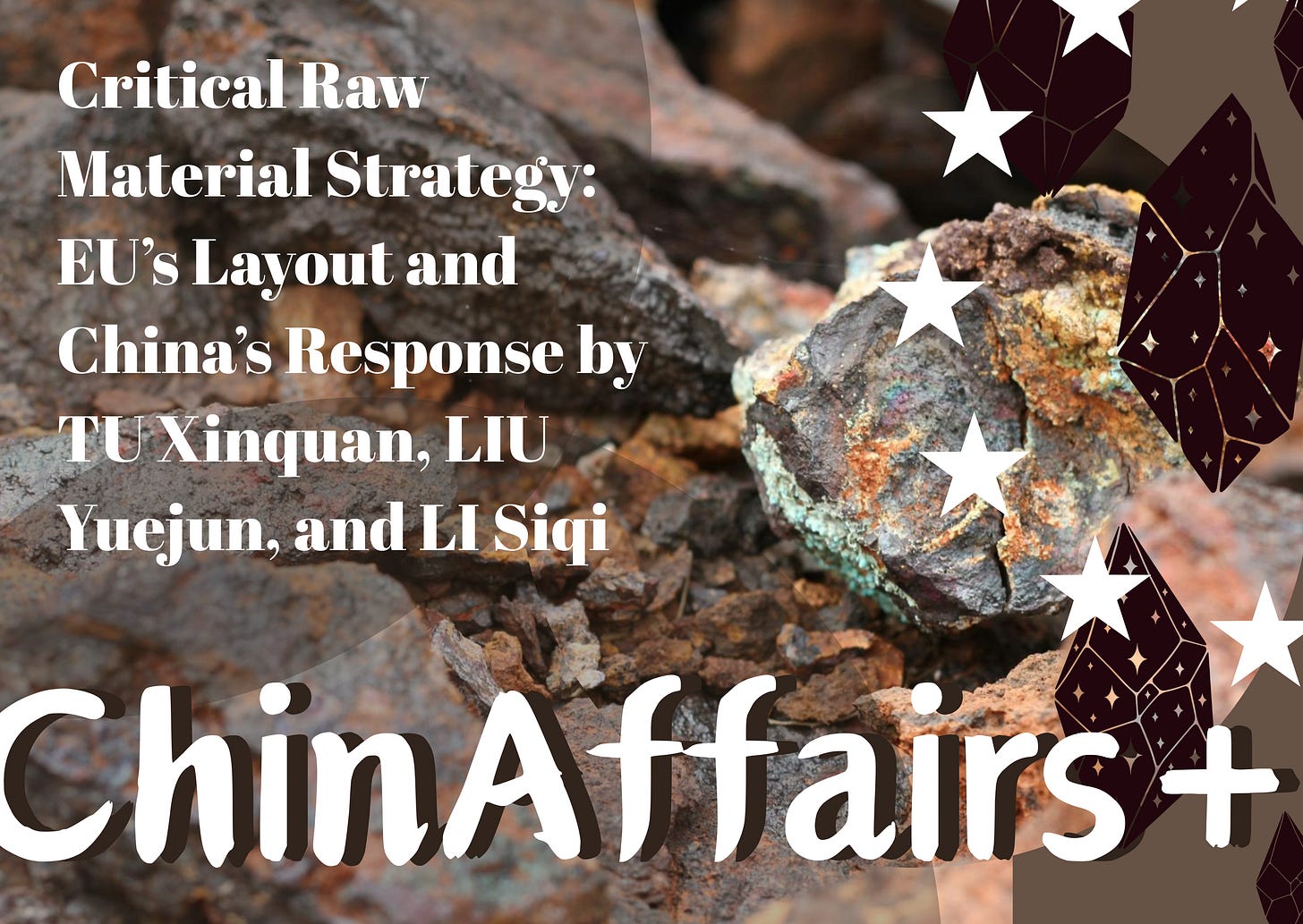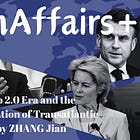Critical Raw Material Strategy: EU’s Layout and China’s Response by TU Xinquan, LIU Yuejun, and LI Siqi
The new supply chain architecture has not yet taken shape, but its outline is gradually emerging amid the interplay of major power games and global collaboration.
Welcome to the 48th edition of our weekly newsletter! I'm SUN Chenghao, a fellow with the Center for International Security and Strategy (CISS) at Tsinghua University, Council Member of The Chinese Association of American Studies, a visiting scholar at Paul Tsai China Center of Yale Law School in 2024 and Munich Young Leader 2025.
ChinAffairsplus is a newsletter that shares articles by Chinese academics on topics such as China's foreign policy, China-U.S. relations, China-Europe relations, and more. This newsletter was co-founded by my research assistant, ZHANG Xueyu, and me.
Through carefully selected Chinese academic articles, we aim to provide you with key insights into the issues that China's academic and strategic communities are focused on. We will highlight why each article matters and the most important takeaways. Questions and feedback can be addressed to sch0625@gmail.com
Today, we have selected an article written by TU Xinquan, LIU Yuejun, and LI Siqi, which focuses on the EU’s Critical Raw Material Strategy and its impact on China.
Summary
Guided by the goal of a green economic transition, the EU has seen exponential growth in its demand for critical raw materials, yet its supply remains highly dependent on external sources, especially China. Driven by economic and security motivations, the EU has elevated critical raw materials to a strategic level, aiming to build localized supply chains and reduce import dependence on China. This will undermine the mutual trust between China and the EU bilateral and their cooperation over environmental issues, while exacerbating the risks China faces in the restructuring of global critical raw material supply chains.
In the short term, it will be difficult for the EU to cast off its dependence on China in critical raw materials. However, it is expected that in the future, the EU will further strengthen the strategic value of its international network, and uncertainties persist in the implementation of its strategy.
China should adhere to the fundamental principle of mutual benefit and win-win cooperation with the EU, and maintain friendly and cooperative China-EU relations by enhancing mutual trust, expanding the scope of economic and trade cooperation, and strengthening the stability of its own supply chains, so as to proactively respond to new changes in the competitive landscape of critical raw materials.
Why It Matters
In recent years, guided by the goals of energy transition and climate change mitigation, many economies have formulated and implemented renewable energy plans to promote green transformation. Critical raw materials are resources that occupy a fundamental position in the development of modern high-tech industries, green industries, defense industries, and other sectors, playing an indispensable role in green manufacturing and the promotion of clean technology. Global demand for them is growing rapidly, while their supply is concentrated and imbalanced, which has intensified global competition. In the current transitional global order marked by the restructuring of global industrial chains and escalating geopolitical conflicts, critical raw materials have become an important component of major powers’ national security strategies, a “new battlefield” for strategic competition, and a significant factor influencing China-EU relations.
In the current situation, analyzing the specific measures related to, intrinsic motivations of, and future development trends of the EU’s critical raw materials strategy, and its impact on China, is crucial for enhancing the resilience of China’s supply chains and transforming China and the EU into “key partners in mutual economic and trade cooperation, priority partners in scientific and technological cooperation, and trusted partners in industrial and supply chain cooperation.”
Key Points
The Key Content and Implementation Path of the EU’s Critical Raw Materials Strategy
Key Content
The current goal of the EU’s critical raw materials strategy is to establish a standardized legal framework for market operations, and ensure the security, efficiency, flexibility, and sustainability of supply chains. As outlined in the Critical Raw Materials Act, the EU has set three policy objectives: first, to establish a dynamic list of critical raw materials; second, to formulate standards for the local supply of critical raw materials; and third, to stipulate standards for diversifying the sources of critical raw materials. Among these, the list of critical raw materials serves as a key tool for the EU’s critical raw materials strategy. Its formulation is the responsibility of the European Commission, and is a dynamic mechanism updated every three years. Additionally, the EU emphasizes technological research and the cultivation of innovative talents related to raw materials. Externally, the EU is strengthening trade in critical raw materials, consolidating friendly relations with supply chain partner countries, and emphasizing active engagement in trade and investment negotiations and maintaining policy dialogue with major trading partners to reduce trade barriers for critical raw materials.
Implementation Path
First, the EU continues to advance the localization of production, requiring its member states to boost the development of industries involved in the mining, extraction, and processing of critical raw materials. Second, it aims to reduce import dependence on China and focus on achieving supply diversification. Third, it is stepping up efforts in the recycling of raw materials. Finally, to uphold free movement and environmental sustainability, the EU requires member states to enhance the durability, recyclability, and repairability of critical raw materials and related products, guarantee their free flow within the EU market, and ensure that all links in the supply chain comply with environmental protection and social responsibility standards.
Underlying Motivations behind the EU’s Strategic Layout for Critical Raw Materials
Economic Motivations
To address the environmental crisis and advance green economic transformation, the EU’s energy system has begun shifting from fossil fuels to clean energy, driving exponential growth in demand for critical raw materials. However, the EU has relatively low reserves of critical raw materials and relies heavily on imports, while China maintains a leading position in reserves of as well as the extraction, refining, processing and manufacturing of critical raw materials. Consequently, the EU faces a supply-demand imbalance in the global critical raw materials market and is highly dependent on China. Safeguading the supply of critical raw materials and promoting the development of green industries have thus become the direct motivations for the EU’s strategic layout for critical raw materials.
Security Motivations
Against the backdrop of protectionism and de-globalization, global supply chains have become increasingly vulnerable, with power and security emerging as key motivations for reshaping supply chains. As the foundation of green supply chains and the basis of a new metric for power in energy, critical raw materials have become a key battlefield for international strategic competition, which is tending towards weaponization, politicization, and instrumentalization. Many countries have adopted resource monopoly policies, further exacerbating supply chain risks. As a resource-dependent economy, the EU attaches great importance to mineral security. Nevertheless, factors such as great power competition and the pandemic heightened its vigilance over potential “political coercion” due to differences in values. Given its heavy reliance on China for critical raw materials, China’s countermeasures to EU sanctions have exposed the EU to the risk of supply chain disruptions. Therefore, ensuring supply chain security holds long-term strategic significance for the EU’s development.
The Future of the EU’s Critical Raw Materials Strategy
Challenges for the Implementation of the EU’s Critical Raw Materials Strategy
Internally, the development and utilization of local resources in the EU face resistance: the mining industry is in decline, with weak capacity-building; projects are costly, located in remote areas, and have long construction cycles; due to long construction periods, high price volatility, and high investment risks, enterprises lack motivation to invest; mining and processing projects tend to damage the environment and infringe on the rights of local residents, triggering public opposition.
Externally, it is difficult to explore overseas mining markets. At the policy level, there is a lack of phased plans to expand overseas supplies. At the practical level, traditional free trade agreements struggle to promote supply diversification; the “Critical Raw Materials Club” lacks detailed routes for implementation and supporting resources; countries supplying critical raw materials have a strong awareness of resource protection, and the EU’s mere pursuit of supplies makes it likely to arouse suspicion.
The Future Direction of the EU’s Critical Raw Materials Strategy
Compared with the United States’ exclusive and hostile attitude toward China, the EU’s critical raw materials strategy is relatively moderate. Moreover, the EU’s own production of critical raw materials cannot meet its energy transition needs, making it difficult to cast off its dependence on China in the short term.
It is expected that in the future, the EU’s critical raw materials strategy will elevate accelerating investment in overseas projects and promoting broader international cooperation to a higher strategic position. At the legislative level, EU legislation on critical raw materials may not include mandatory clauses excluding China, but it will adopt more specific measures in areas such as expanding overseas projects and establishing new cooperative relationships. China needs to be vigilant against its collaboration with the U.S. and others to achieve the “de-Chinaization” of the global critical raw materials supply chain through gradual and tiered legislation.
The Impact of the EU’s Critical Raw Materials Strategy on China
In the short term, the EU’s Critical Raw Materials Strategy will affect China’s upstream control and China-EU bilateral mutual trust.
The critical raw materials strategy will not have a significant impact on China’s exports of critical raw materials. However, in processing and refining, there remains a substantial gap between the production capacity scale of Chinese enterprises and that of European transnational mining giants. In the future, European enterprises may squeeze the market share of Chinese mineral processing and refining enterprises both in Europe and globally. Chinese enterprises will face greater volatility in demand, and the risks related to monitoring of sustainability and legality for exports to Europe will rise. On the other hand, the EU has joined U.S.-led mineral supply organizations, which will heighten the political sensitivity of China-EU cooperation, undermine mutual trust between the two powers, and may even disrupt existing China-EU industrial cooperation. Moreover, the implementation of the EU’s critical raw materials strategy will intensify competition between China and the EU over overseas mineral bases, increasing the likelihood of China-EU economic frictions.
In the medium term, it will impact China-EU trade and investment cooperation in the new energy industry.
In terms of investment, the EU’s critical raw materials strategy exhibits a tendency toward regional protectionism, which may result in investment restrictions on the overseas mining projects of Chinese upstream mineral enterprises. In terms of trade, after the EU achieves localized production and diversified supply, it is likely to interfere with China’s investment and trade in industries such as lithium batteries and electric vehicles through trade barriers, trade controls, and political pressure, thereby increasing the risk of trade disputes and frictions for downstream industries.
In the long term, the external macro environment will undermine the stability of China’s development.
On one hand, great-power rivalry surrounding critical raw materials will disrupt the international market, going against China’s efforts to maintain its existing advantageous position. On the other hand, the new critical raw materials supply chain regime that the EU seeks to establish will weaken China’s influence in the global supply chain system. Consequently, China’s supply-demand gap for critical raw materials will continue to widen. Given the limited global mineral resources, if the Europe-U.S.-led critical raw materials alliance adopts “bloc-based” export control policies, China will face more severe supply risks.
China’s Coping Strategies
First, China must enhance the mutual trust between China and the EU in investments and reduce the necessity of strategic implementation.
At the domestic level, China should adhere to the basic stance of mutual benefit and win-win results, actively convey a willingness for friendly cooperation to the EU and other partners and alleviate the EU’s concerns through China-EU high-level dialogues. It should respond positively to areas of EU concern such as market access, so as to enhance the stickiness of China-EU markets. At the external level, first of all, China should actively participate in cooperative projects in the international critical raw material industrial chain and adhere to open cooperation to combat acts that disrupt the stability of the global industrial chain. It should strengthen the relevance of the China-EU critical raw material industrial chain, thereby reducing the necessity and stringency of the implementation of the EU’s critical raw material strategy. Finally, China should advance the existing China-EU early warning mechanism for critical raw materials and seek new cooperation mechanisms.
Second, China should improve the competitiveness of related products and expand the scope of economic and trade cooperation.
On the one hand, in order to create export advantages for China’s critical raw materials industries, efforts should be made to enhance enterprises’ capabilities in sustainable, refined, and high-end production. On the other hand, China should strengthen China-EU strategic communication, jointly promote the construction of local and third-party clean energy infrastructure with the EU, deepen R&D collaboration on traction batteries, and further expand the market scale of electric vehicles.
Third, China should actively respond to changes in the global landscape and enhance the stability of domestic supply chains.
The first priority is “chain extension”: carry out extensive cooperation in international mining investment to help form a diversified domestic supply chain layout; actively participate in the construction of international alliances to the ends of strengthening critical raw material supply chains and formulating international industry standards and market rules. The second is “chain strengthening”: further promoting the application of medium and high-end technologies and encouraging pioneering enterprises to participate in international cooperation. The third task is “chain supplementation”: China should establish a supply chain risk assessment mechanism as soon as possible, form a flexible and dynamic list of strategic mineral resources, and identify and address weak links in the supply chain.
Conclusion
The global supply chain of critical raw materials is standing at a crossroads: driven by the dual forces of strategic competition among major powers and the green transition, will it fall into fragmentation and geopoliticization, or can it forge a new path of diversified collaboration, efficiency and stability? The advancement of the EU’s Critical Raw Materials Act heightens this uncertainty. While its goals of local production and supply diversification have clear directions, they are constrained by realities such as limited domestic resources, long project cycles and public opposition to environmental impacts, making it hard to cast off dependence on China in the short term.
Currently, alliances such as the U.S.-EU-led "Minerals Security Partnership" have resulted in strategic tension with China’s stance of open collaboration. The EU’s “de-risking” strategy and China’s belief in “shared responsibility” continue to contend with one another, and the game between the politicization of supply chains and market rules is becoming increasingly intense.
However, this pattern is not set in stone. The future direction of these developments depends on whether China and the EU can uphold the bottom line of cooperation amid competition, and also on whether the countries choose mutual benefit and win-win cooperation over alignment and subservience. The new supply chain architecture has not yet taken shape, but its outline is gradually emerging amid the interplay of major power games and global collaboration.
About the Author
屠新泉 Tu Xinquan: Tu Xinquan is Dean and Professor of the China Institute for WTO Studies of University of International Business and Economics(UIBE) located in Beijing, China. He is currently the Chair Holder of WTO Chairs Program at UIBE and general secretary of Network on International Trade and Investment System(NITIS) and a member of Friends of Multilateralism Group, Asian WTO Research Network, WEF Trade Action Group, and Trade and Investment Research Network. He got his Ph.D. in international trade from this university in 2004. His research and teaching focus on Chinese trade policy, WTO, Government procurement, US trade policy, and US-China trade relations.
About the Publication
The Chinese version of the article was published by Global Review(《国际展望》). This journal is an academic journal on international relations published in both Chinese and English. It is sponsored by the Shanghai Institutes for International Studies. The journal focuses on fields such as Chinese diplomacy, global governance, and international security. It features special columns including “Artificial Intelligence and International Relations” and “Regional and Country Studies”.
As a CSSCI source journal and a Peking University Core Journal, it has a composite impact factor of 1.7 and a comprehensive impact factor of 3.09, ranking among the top in journals on international politics.










